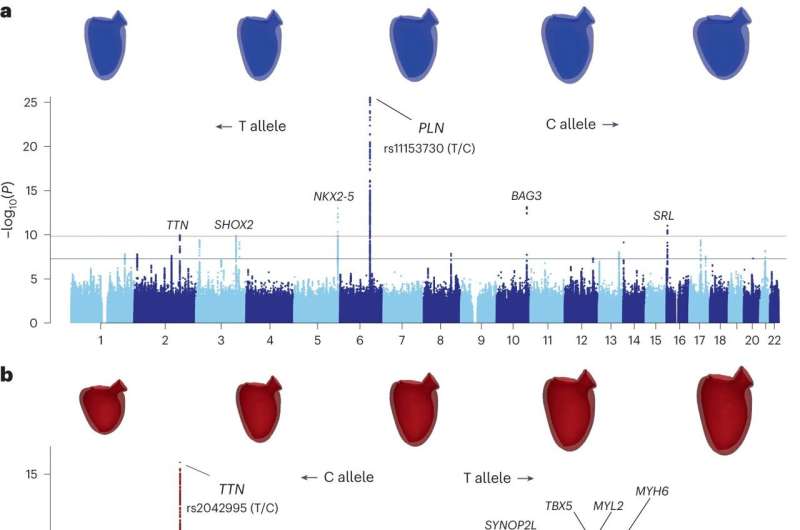This article has been reviewed according to Science X's editorial process and policies. Editors have highlighted the following attributes while ensuring the content's credibility:
fact-checked
trusted source
proofread
AI research gives unprecedented insight into heart genetics and structure

A study has used AI to understand the genetic underpinning of the heart's left ventricle, using three-dimensional images of the organ. It was led by scientists at the University of Manchester, with collaborators from the University of Leeds (U.K.), the National Scientific and Technical Research Council (Santa Fe, Argentina), and IBM Research (Almaden, CA).
The highly interdisciplinary team used cutting-edge unsupervised deep learning to analyze more than 50,000 three-dimensional MRI of the heart from UK Biobank, a biomedical database and research resource.
The study, published in the journal Nature Machine Intelligence, focused on uncovering the intricate genetic underpinnings of cardiovascular traits. The research team conducted comprehensive genome-wide association studies (GWAS) and transcriptome-wide association studies (TWAS), resulting in the discovery of 49 novel genetic locations showing an association with morphological cardiac traits with high statistical significance, as well as 25 additional loci with suggestive evidence.
The study's findings have significant implications for cardiology and precision medicine. By elucidating the genetic basis of cardiovascular traits, the research paves the way for the development of targeted therapies and interventions for individuals at risk of heart disease.
The research was directed by Prof Alejandro F. Frangi, Director of the Christabel Pankhurst Institute for Health Technology Research and Innovation, the Bicentennial Turing Chair for Computational Medicine, and a Royal Academy of Engineering Chair in Emerging Technologies. The first author was Rodrigo Bonazzola, a Ph.D. candidate, jointly co-supervised by Prof Frangi, Dr. Enzo Ferrante (CONICET, Argentina) and Dr. Tanveer Syeda-Mahmood (IBM Fellow and Chief Scientist at IBM Research).
Prof Frangi said, "This is an achievement which once would have seemed like science fiction, but we show that it is completely possible to use AI to understand the genetic underpinning of the left ventricle, just by looking at three-dimensional images of the heart.
"Previous studies have only investigated association of traditional clinical phenotypes, such as left ventricular mass or stroke volume, limiting the number of gene associations detected for a given study size. However, this study used AI not only to delineate the cardiac chambers from three-dimensional medical images at pace but also to unveil novel genetic loci associated with various cardiovascular deep phenotypes."
He added, "This research exemplifies the power of multidisciplinary teams and international collaborations, bolstered by UK Biobank's valuable data. By marrying genetic data with cardiac imaging through advanced machine learning, we've gained novel insights into the factors shaping cardiovascular health."
Early career scientist and rising star, Bonazzola, the study's lead author said, "Our research reveals genes that harbor mutations known to be detrimental to other organisms, yet the impact of common variations within these genes on cardiac structure across the human population had not been previously documented. For instance, the STRN gene, recognized for its harmful variants leading to dilated cardiomyopathy in dogs, exhibits a common variant in humans that seems to induce a subtle but detectable change in mitral orientation."
Dr. Ferrante said, "The study's core achievement is a robust method based on geometric deep learning for large-scale genetic and cardiac imaging data analysis, leading to ground-breaking genetic insights related to heart structure. These discoveries could revolutionize our approach to disease understanding, drug development, and precision medicine in cardiology. The study's thorough analysis and ensemble-based methods also enhance the discovery rates and the reliability of our findings."
Prof. Keavney, BHF professor of cardiovascular medicine at the University of Manchester, emphasized the transformative methodology. He said, "Employing cutting-edge deep learning to integrate genetic and imaging data has shed light on the genetic underpinnings of heart structure. This approach is a beacon for future organ studies and understanding genetic influences on organ anatomy."
Prof Plein, BHF professor of cardiovascular imaging in Leeds, said, "Cardiovascular MRI plays a crucial role in understanding disease phenotypes, allowing us to uncover genetic associations that help stratify cardiovascular diseases, ultimately leading to better treatments and precision medicine."
Professor Frangi added, "Our publication marks a significant stride in correlating deep cardiovascular imaging traits with genetic data. It paves the way for revolutionary progress in cardiovascular research, clinical practices, and tailored patient care."
Professor Bryan Williams, chief scientific and medical officer at the British Heart Foundation, said, "This new research shows the huge power of big data linking genes to heart structure. Machine learning has made this possible by transforming how we process, analyze and gain insights from big data to tackle the biggest questions in cardiovascular research. This pioneering new method has uncovered many more genes that influence the structure and function of the heart, which will lead to new insights into why abnormal structure and function can lead to heart disease.
"Heart and circulatory diseases are still devastating millions of lives each year in the U.K. AI could unlock more information about the genes that contribute to the structure of the heart. In future this could lead to real improvements for patients, including the development of tailored, precision treatments for people with heart problems."
More information: Rodrigo Bonazzola et al, Unsupervised ensemble-based phenotyping enhances discoverability of genes related to left-ventricular morphology, Nature Machine Intelligence (2024). DOI: 10.1038/s42256-024-00801-1





















